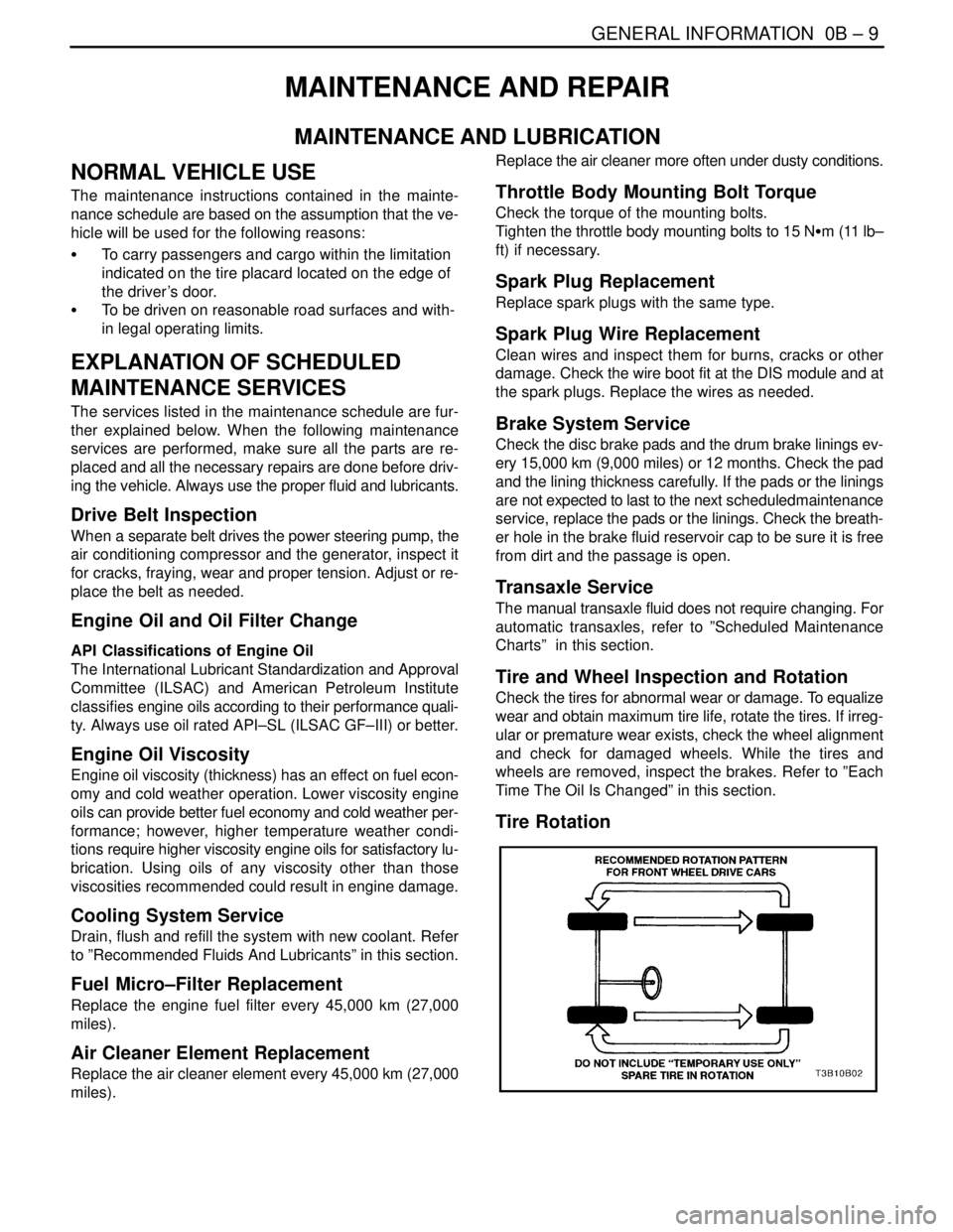2004 DAEWOO LACETTI driver
[x] Cancel search: driverPage 5 of 2643

v
TABLE OF CONTENTS
Section 0B General Information
Section 1 Engine
Section 1A General Engine Information
Section 1C1 1.4L/1.6L DOHC Engine Mechanical
Section 1C2 1.8L DOHC Engine Mechanical
Section 1D Engine Cooling
Section 1E Engine Electrical
Section 1F Engine Controls
Section 1G Engine Exhaust
Section 2 Suspension
Section 2A Suspension Diagnosis
Section 2B Wheel Alignment
Section 2C Front Suspension
Section 2D Rear Suspension
Section 2E Tires and Wheels
Section 3 Driveline/Axle
Section 3A Automatic Transaxle Drive Axle
Section 3B Manual Transaxle Drive Axle
Section 4 Brakes
Section 4A Hydraulic Brakes
Section 4B Master Cylinder
Section 4C Power Booster
Section 4D Front Disc Brakes
Section 4E1 Rear Disc Brakes
Section 4E2 Rear Drum Brakes
Section 4F Antilock Brake System
Section 4G Parking Brake
Section 5 Transmission/Transaxle
Section 5A1 ZF 4HP16 Automatic Transaxle
Section 5A2 AISIN Automatic Transaxle
Section 5B Five-Speed Manual Transaxle
Section 5C Clutch
Section 6 Steering
Section 6A Power Steering System
Section 6B Power Steering PumpSection 6C Power Steering Gear
Section 6E Steering Wheel and Column
Section 7 Heating, Ventilation, and Air
Conditioning (HVAC)
Section 7A Heating and Ventilation System
Section 7B Manual Control Heating, Ventilation,
and Air Conditioning System
Section 7D Automatic Temperature Control HVAC
Section 8 Restraints
Section 8A Seat Belts
Section 8B Supplemental Inflatable Restraints
(SIR)
Section 9 Body and Accessories
Section 9A Body Wiring System
Section 9B Lighting Systems
Section 9C Horns
Section 9D Wipers/Washer Systems
Section 9E Instrumentation/Driver Information
Section 9F Audio Systems
Section 9G Interior Trim
Section 9H Seats
Section 9I Waterleaks
Section 9J Windnoise
Section 9K Squeaks and Rattles
Section 9L Glass and Mirrors
Section 9M Exterior Trim
Section 9N Frame and Underbody
Section 9O Bumpers and Fascias
Section 9P Doors
Section 9Q Roof
Section 9R Body Front End
Section 9S Body Rear End
Section 9T1 Remote Keyless Entry and Anti–Theft
System
Section 9T2 Immobilizer Anti–Theft System
Page 16 of 2643

GENERAL INFORMATION 0B – 9
DAEWOO V–121 BL4
MAINTENANCE AND REPAIR
MAINTENANCE AND LUBRICATION
NORMAL VEHICLE USE
The maintenance instructions contained in the mainte-
nance schedule are based on the assumption that the ve-
hicle will be used for the following reasons:
S To carry passengers and cargo within the limitation
indicated on the tire placard located on the edge of
the driver’s door.
S To be driven on reasonable road surfaces and with-
in legal operating limits.
EXPLANATION OF SCHEDULED
MAINTENANCE SERVICES
The services listed in the maintenance schedule are fur-
ther explained below. When the following maintenance
services are performed, make sure all the parts are re-
placed and all the necessary repairs are done before driv-
ing the vehicle. Always use the proper fluid and lubricants.
Drive Belt Inspection
When a separate belt drives the power steering pump, the
air conditioning compressor and the generator, inspect it
for cracks, fraying, wear and proper tension. Adjust or re-
place the belt as needed.
Engine Oil and Oil Filter Change
API Classifications of Engine Oil
The International Lubricant Standardization and Approval
Committee (ILSAC) and American Petroleum Institute
classifies engine oils according to their performance quali-
ty. Always use oil rated API–SL (ILSAC GF–III) or better.
Engine Oil Viscosity
Engine oil viscosity (thickness) has an effect on fuel econ-
omy and cold weather operation. Lower viscosity engine
oils can provide better fuel economy and cold weather per-
formance; however, higher temperature weather condi-
tions require higher viscosity engine oils for satisfactory lu-
brication. Using oils of any viscosity other than those
viscosities recommended could result in engine damage.
Cooling System Service
Drain, flush and refill the system with new coolant. Refer
to ”Recommended Fluids And Lubricants” in this section.
Fuel Micro–Filter Replacement
Replace the engine fuel filter every 45,000 km (27,000
miles).
Air Cleaner Element Replacement
Replace the air cleaner element every 45,000 km (27,000
miles).Replace the air cleaner more often under dusty conditions.
Throttle Body Mounting Bolt Torque
Check the torque of the mounting bolts.
Tighten the throttle body mounting bolts to 15 NSm (11 lb–
ft) if necessary.
Spark Plug Replacement
Replace spark plugs with the same type.
Spark Plug Wire Replacement
Clean wires and inspect them for burns, cracks or other
damage. Check the wire boot fit at the DIS module and at
the spark plugs. Replace the wires as needed.
Brake System Service
Check the disc brake pads and the drum brake linings ev-
ery 15,000 km (9,000 miles) or 12 months. Check the pad
and the lining thickness carefully. If the pads or the linings
are not expected to last to the next scheduledmaintenance
service, replace the pads or the linings. Check the breath-
er hole in the brake fluid reservoir cap to be sure it is free
from dirt and the passage is open.
Transaxle Service
The manual transaxle fluid does not require changing. For
automatic transaxles, refer to ”Scheduled Maintenance
Charts” in this section.
Tire and Wheel Inspection and Rotation
Check the tires for abnormal wear or damage. To equalize
wear and obtain maximum tire life, rotate the tires. If irreg-
ular or premature wear exists, check the wheel alignment
and check for damaged wheels. While the tires and
wheels are removed, inspect the brakes. Refer to ”Each
Time The Oil Is Changed” in this section.
Tire Rotation
Page 278 of 2643

1F – 32IENGINE CONTROLS
DAEWOO V–121 BL4
ON–BOARD DIAGNOSTIC (EOBD) SYSTEM CHECK
(1.4L/1.6L DOHC)
Circuit Description
The On–Board Diagnostic (EOBD) system check is the
starting point for any driveability complaint diagnosis. Be-
fore using this procedure, perform a careful visual/physi-
cal check of the engine control module (ECM) and the en-
gine grounds for cleanliness and tightness.
The EOBD system check is an organized approach to
identifying a problem created by an electronic engine con-
trol system malfunction.
Diagnostic Aids
An intermittent may be caused by a poor connection,
rubbed–through wire insulation or a wire broken inside the
insulation. Check for poor connections or a damaged har-
ness. Inspect the ECM harness and connections for im-
proper mating, broken locks, improperly formed or dam-
aged terminals, poor terminal–to–wire connection, and
damaged harness.Test Description
Numbers below refer to the step number on the Diagnostic
Chart:
1. The Malfunction Indicator Lamp (MIL) should be
ON steady with the ignition ON and the engine
OFF. If not, go to ”Diagnostic Aids”.
2. Checks the Class 2 data circuit and ensures that
the ECM is able to transmit serial data.
3. This test ensures that the ECM is capable of con-
trolling the MIL and the MIL driver circuit is not
shorted to ground.
4. If the engine will not start, refer to ”Engine Cranks
But Will Not Run” in this section.
7. A scan tool parameter which is not within the typical
range may help to isolate the area which is causing
the problem.
10. This vehicle is equipped with a ECM which utilizes
an Electrically Erasable Programmable Read Only
Memory (EEPROM). The replacement ECM must
be programmed. Refer to the latest Techline proce-
dure for ECM reprogramming.
Page 280 of 2643

1F – 34IENGINE CONTROLS
DAEWOO V–121 BL4
ON–BOARD DIAGNOSTIC (EOBD) SYSTEM CHECK
(1.8L DOHC)
Circuit Description
The On–Board Diagnostic (EOBD) system check is the
starting point for any driveability complaint diagnosis. Be-
fore using this procedure, perform a careful visual/physi-
cal check of the engine control module (ECM) and the en-
gine grounds for cleanliness and tightness.
The EOBD system check is an organized approach to
identifying a problem created by an electronic engine con-
trol system malfunction.
Diagnostic Aids
An intermittent may be caused by a poor connection,
rubbed–through wire insulation or a wire broken inside the
insulation. Check for poor connections or a damaged har-
ness. Inspect the ECM harness and connections for im-
proper mating, broken locks, improperly formed or dam-
aged terminals, poor terminal–to–wire connection, and
damaged harness.Test Description
Numbers below refer to the step number on the Diagnostic
Chart:
1. The Malfunction Indicator Lamp (MIL) should be
ON steady with the ignition ON and the engine
OFF. If not, go to”Diagnostic Aids”.
2. Checks the Class 2 data circuit and ensures that
the ECM is able to transmit serial data.
3. This test ensures that the ECM is capable of con-
trolling the MIL and the MIL driver circuit is not
shorted to ground.
4. If the engine will not start, refer to ”Engine Cranks
But Will Not Run” in this section.
7. A scan tool parameter which is not within the typical
range may help to isolate the area which is causing
the problem.
10. This vehicle is equipped with a ECM which utilizes
an Electrically Erasable Programmable Read Only
Memory (EEPROM). The replacement ECM must
be programmed. Refer to the latest Techline proce-
dure for ECM reprogramming.
Page 305 of 2643

ENGINE CONTROLS 1F – 59
DAEWOO V–121 BL4
Malfunction Indicator Lamp On Steady (1.4L/1.6L DOHC)
StepActionValue(s)YesNo
1Perform an On–Board Diagnostic (EOBD) system
check.
Is the check complete.–Go to Step 2Go to
”On–Board
Diagnostic Sys-
tem Check”
21. Turn the ignition switch to LOCK.
2. Install the scan tool to the Data Link Connector
(DLC).
3. Command the Malfunction Indicator Lamp
(MIL) ON and OFF.
Does the MIL turn ON and OFF when commanded?–Go to Step 7Go to Step 3
31. Turn the ignition switch to LOCK.
2. Disconnect the Engine Control Module (ECM)
connector.
3. Turn the ignition switch to ON.
Is the MIL off?–Go to Step 6Go to Step 4
4Check the MIL control circuit for a short to ground
and repair as needed.
Is the repair complete?–Go to Step 7Go to Step 5
5Replace the instrument panel cluster. Refer to Sec-
tion 9E, Instrumentation/Driver Information.
Is the repair complete?–Go to Step 7–
6Replace the ECM.
Is the repair complete?–Go to Step 7–
71. Using the scan tool, clear the Diagnostic
Trouble Codes(DTCs).
2. Attempt to start the engine.
Does the engine start and continue to run?–Go to Step 8Go to Step 1
81. Allow the engine to idle until normal operating
temperature is reached.
2. Check if any DTCs are set.
Are any DTCs displayed that have not been diag-
nosed?–Go to
Applicable DTC
tableSystem OK
Page 307 of 2643

ENGINE CONTROLS 1F – 61
DAEWOO V–121 BL4
Malfunction Indicator Lamp On Steady (1.8L DOHC)
StepActionValue(s)YesNo
1Perform an On–Board Diagnostic (EOBD) system
check.
Is the check complete.–Go to Step 2Go to
”On–Board
Diagnostic Sys-
tem Check”
21. Turn the ignition switch to LOCK.
2. Install the scan tool to the Data Link Connector
(DLC).
3. Command the Malfunction Indicator Lamp
(MIL) ON and OFF.
Does the MIL turn ON and OFF when commanded?–Go to Step 7Go to Step 3
31. Turn the ignition switch to LOCK.
2. Disconnect the Engine Control Module (ECM)
connector.
3. Turn the ignition switch to ON.
Is the MIL off?–Go to Step 6Go to Step 4
4Check the MIL control circuit for a short to ground
and repair as needed.
Is the repair complete?–Go to Step 7Go to Step 5
5Replace the instrument panel cluster. Refer to
Section 9E, Instrumentation/Driver Information.
Is the repair complete?–Go to Step 7–
6Replace the ECM.
Is the repair complete?–Go to Step 7–
71. Using the scan tool, clear the Diagnostic
Trouble Codes(DTCs).
2. Attempt to start the engine.
Does the engine start and continue to run?–Go to Step 8Go to Step 1
81. Allow the engine to idle until normal operating
temperature is reached.
2. Check if any DTCs are set.
Are any DTCs displayed that have not been diag-
nosed?–Go to
” Applicable
DTC table”System OK
Page 325 of 2643

ENGINE CONTROLS 1F – 79
DAEWOO V–121 BL4
IDLE AIR CONTROL SYSTEM CHECK (1.4L/1.6L DOHC)
Circuit Description
The aim of the MTIA (Main Throttle Idle Actuator) is to con-
trol the idle speed with the throttle body itself. The throttle
is motorized for low opening angle (0°C, 19°C). The char-
acteristics of the airflow are not the same for low and high
opening angles. As a matter of fact, the gradient of the
mass air flow function of TPS is lower for small angles that
permits to be more precise during the idle speed control.
Out of idle speed the throttle is actuated mechanically by
a classical bowdencable.
The main throttle idle actuator (MTIA) provides a voltagesignal that changes in relation to the throttle plate angle.
The signal voltage will vary from about nearly 5.0 V at idles
to about 0.2V to 0.4 V at wide–open throttle. The TPS is
one of the most important inputs used by the ECM for fuel
control and other functions such as idle, wide open
throttle, deceleration enleanment, and acceleration en-
richment.
Diagnostic Aids
If the idle is too high, stop the engine. Fully extend the main
throttle idle actuator (MTIA) with a IAC driver. Start the en-
gine. If the idle speed is above 800 rpm, locate and repair
the vacuum leak. Also, check for a binding throttle plate or
throttle linkage or an incorrect base idle setting.
Page 328 of 2643

1F – 82IENGINE CONTROLS
DAEWOO V–121 BL4
IDLE AIR CONTROL SYSTEM CHECK (1.8L DOHC)
Circuit Description
The Engine Control Module (ECM) controls the engine idle
speed with the Idle Air Control (IAC) valve. To increase the
idle speed, the ECM pulls the IAC pintle away from its seat,
allowing more air to pass by the throttle body. To decrease
the idle speed, it extends the IAC valve pintle toward its
seat, reducing bypass air flow. A scan tool will read the
ECM commands to the IAC valve in counts. The higher
counts indicate more air bypass (higher idle). The lower
counts indicate less air is allowed to bypass (lower idle).
Diagnostic Aids
If the idle is too high, stop the engine. Fully extend the Idle
Air Control (IAC) valve with a IAC driver. Start the engine.
If the idle speed is above 800 rpm, locate and repair the
vacuum leak. Also, check for a binding throttle plate or
throttle linkage or an incorrect base idle setting.
Test Description
The number(s) below refer to step(s) on the diagnostic
table.
2. The IAC valve is extended and retracted by the IAC
driver. IAC valve movement is verified by an engine
speed change. If no change in engine speed oc-
curs, the valve can be removed from the throttle
body and tested. Connect the IAC driver to the re-
moved IAC valve and turn the ignition ON. Do not
start the engine.5. This step checks the quality of the IAC valve move-
ment in Step 2. Fully extending the IAC valve may
cause an engine stall. This may be normal.
6. Steps 2 and 5 verify proper IAC valve operation.
This step checks the IAC circuit for a wiring or ECM
fault.
Idle Air Control Valve Reset Procedure
Whenever the battery cable or the Engine Control Module
(ECM) connector or the ECM fuse Ef11 is disconnected or
replaced, the following idle learn procedure must be per-
formed:
1. Turn the ignition ON for 5 seconds.
2. Turn the ignition OFF for 10 seconds.
3. Turn the ignition ON for 5 seconds.
4. Start the engine in park/neutral.
5. Allow the engine to run until the engine coolant is
above 185°F (85°C).
6. Turn the A/C ON for 10 seconds, if equipped.
7. Turn the A/C OFF for 10 seconds, if equipped.
8. If the vehicle is equipped with an automatic trans-
axle, apply the parking brake. While pressing the
brake pedal, place the transaxle in D (drive).
9. Turn the A/C ON for 10 seconds, if equipped.
10. Turn the A/C OFF for 10 seconds, if equipped.
11. Turn the ignition OFF. The idle learn procedure is
complete.